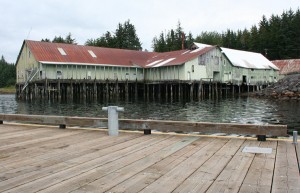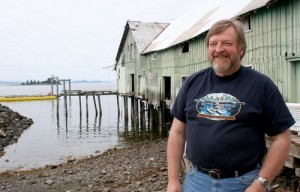In June, the Keku Cannery in Kake was named one of the 11 most endangered historic places in the country by the National Trust for Historic Preservation. The building is an artifact of Alaska’s salmon canning industry and its a reminder of the different people that worked there.
“The heartbeat of the community surrounded the operations at the cannery, back in its heyday,” said Gary Williams.

He’s the Executive Director of the Organized Village of Kake, the town’s tribal government.
Williams and I are standing in front of the Keku Cannery. It’s a series of buildings, propped up on pilings. In front are the tide-flats and Keku Strait on the northern edge of Kupreanof Island. The cannery is a complex of huge pale green warehouses and little outbuildings. There are houses where workers lived and boardwalks connecting them all together.
The cannery is vast and filled with big pieces of machinery. Inside, there are conveyor belts and funnels where cans moved through the plant.
“See these over here was called the retorts, which were essentially gigantic pressure cookers where the canned fish was put in for the sealing process; cooking and sealing.”
In June, the cannery was named one of America’s most endangered historic places. The decision came from the National Trust for Historic Preservation. It was already a National Historic Landmark, a designation it got in 1997. Unlike the historic register, which is usually for houses, landmark designations are reserved for big things. Also on the endangered list this year was the Houston Astrodome, a section of Virginia’s James River, and a lighthouse in Massachusetts.
Basically, naming it an endangered historic place means its nationally important, and it needs attention. Urgently.
“It’s not a matter of if, it’s a matter of when this building falls over, said Rob Meinhardt.”
Meinhardt is the owner of True North Development Solutions, a historic preservation firm that created a plan to stabilize the cannery so hopefully it doesn’t fall over.
He says the Keku Cannery is important because its a good example of the cannery industry in the nation as a while, but even more so, because of the way it shows the labor practices in the industry.
“You would have the Filipinos staying in the bunkhouses over here, fulfilling these sort of roles in the cannery. You would have the Japanese population over here, you would have the Tlingit population, the Alaska Native population over here. It was a highly segregated business operation.”

Gary Williams and the tribe want to tell this old story of the cannery business. But they also want to make it usable, so it can be part of Kake’s economy, again.
“One thing I’ve learned from working with the historic preservation world, is making quote unquote, adaptive reuse is one of the goals, so that the building is utilized and not just sitting dormant.”
Williams says the restored building could be an opportunity for cultural heritage tourism. He lists examples like a performance space for the Ke ex ‘ Kwan Dancers, and shops for local merchants and craftsmen.
But that’s a long way off. Getting the endangered designation doesn’t come with any money. Williams says the estimate for the initial stabilization would be $500,000, and that it would cost millions to restore the cannery.
According to planner, Rob Meinhardt, “The pilings have undergone severe rot, so basically, this huge structure sitting over the tidelands, is sitting on hollow pilings. It’s really kind of scary.”
In the years since the cannery got its initial Historic Landmark status, two buildings in the complex have collapsed. The last one was during a particularly bad windstorm three years ago.
But Meinhardt says the residents of Kake have a reputation for being a very determined group of people. He believes, with their track record and the effort they’re putting in, there’s hope the cannery can be saved.




